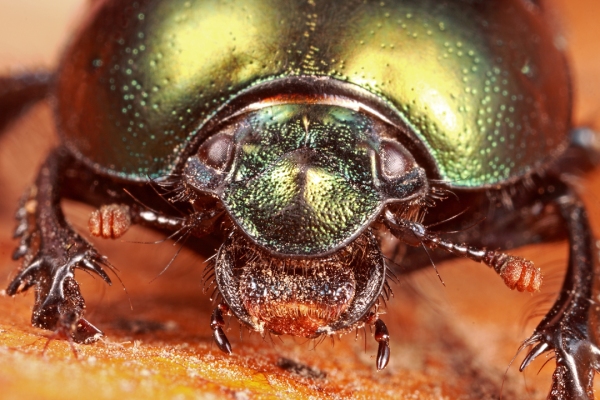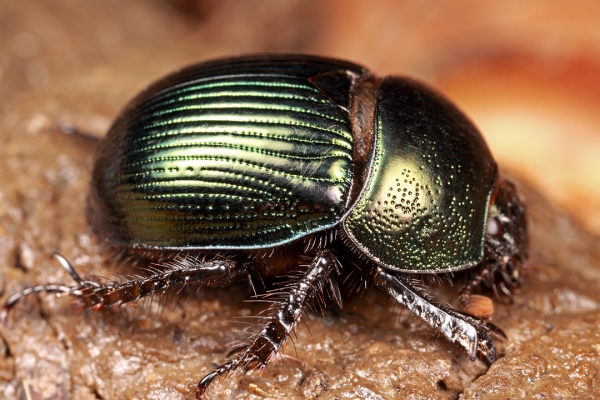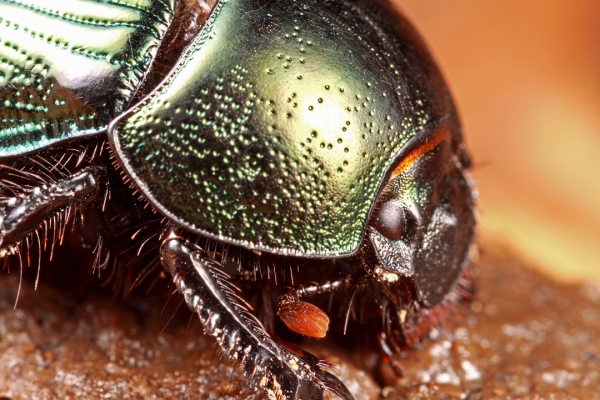
…Their silly little shit-eating grins!
Okay, I know this isn’t a true dung beetle, but this earth-boring scarab (family Geotrupidae) is close enough that I’ll take the opportunity to use one of my favorite dung beetle jokes.¹ This is one of several individuals that I saw on a late October hike along the North Fork Section of the Ozark Trail in extreme south-central Missouri (just a few miles north of the Arkansas border). I regard these beetles to represent the species Geotrupes splendidus based on the punctured elytral striae, sutural striae ending at the scutellum, bright green coloration, and obvious punctures in the lateral areas of the pronotum. Of the half dozen adults that I saw during the day, all were found singly on animal dung or on the ground nearby. This was the most abundantly I’ve ever seen this species—up to that point I’d accumulated only a handful of specimens, always on mild days in late fall or early winter in association with animal dung on trails through high quality woodlands. The timing and circumstance is also true for Geotrupes blackburnii, the only other species in the genus that I have collected in Missouri—albeit much more commonly and abundantly than G. splendidus and easily distinguished from that species by its slightly smaller size, nearly impunctate pronotum and all black coloration.
¹ By the way, I don’t recall the provenance of that joke, other than I saw it as a one-frame cartoon, featuring two entomologists talking to each other, posted on a Department of Entomology door while I was in graduate school—way back in the early 1980s. If you know please tell me!

Geotrupes splendidus miarophagus | Ozark Co., Missouri—yes, it’s sitting on shit!
An interesting contrast between this species and true dung beetles (scarabs in the subfamily Scarabaeinae and representing such genera as Copris, Phanaeus, Canthon, Onthophagus, etc.) is the fact that while this species can and does utilize dung for both larval development and adult feeding, it is not the preferred food. Rather, adults are more often found feeding on fungus, and leaf litter—tightly packed by the adult at the end of a burrow in the soil, is most often used for larval development (Howden 1055). This does not seem to be a universal feature of the genus, as the common Missouri species, G. blackburnii, does seem to prefer dung for larval development. This is not to say that either species is exclusive in its preference—both seem to be more flexible in food choice than the true dung beetles, but in reality the larval biology of a great many species in this and other genera of the family remain unknown.

The opinion of scarab expert would be most helpful at this point. This species is broadly distributed across eastern North America, with eastern populations generally brighter green and western populations (e.g., here in Missouri) more often yellow-green with golden or reddish hints but ranging to dark purple. In fact, all but one of the Missouri specimens in my collection are dark purple, the other being green similar to the six beetles I saw on this date. Howden (1955) recognized the western forms as a separate subspecies, G. splendidus miarophagus (originally described as the species G. miarophagus by Thomas Say). These two subspecies are listed as valid in the recent checklist of Nearctic Scarabaeoidea (Smith 2003), and the specimens in my collection from Missouri are labeled as such by scarab expert Bill Warner. Despite this, most other sources I’ve checked—including BugGuide—list G. miarophagus as a synonym of G. splendidus. Color alone—especially when it is as variable as in this species—seems weak justification for subspecific distinction. Howden (1955) mentions a curious case of G. s. miarophagus utilizing fresh grass clippings for larval development; however, it is difficult to imagine this as anything more than just a very recent adaptation. If there are other reasons supporting subspecific distinction besides deference to Henry Howden, I’d be interested in knowing what they are.
REFERENCES:
Howden, H. F. 1955. Biology and taxonomy of North American beetles of the subfamily Geotrupinae with revisions of the genera Bolbocerosoma, Eucanthus, Geotrupes and Peltotrupes (Scarabaeidae). Proceedings of the United States National Museum 104:151–319.
Smith, A. B. T. 2003. Checklist of the Scarabaeoidea of the Nearctic Realm. Version 3. Electronically published, Lincoln, Nebraska. 74 pp.
Copyright © Ted C. MacRae 2013
It is refreshing to see a nice post about non-traditional dung beetles. The hydrophilids adapted for swimming in poo come to mind. Heck i even give honorary beetle status to Scathophagus because they are so darn cool. I think that even tiger beetles have a poo-ttraction (just like certain entomologists!) – but that is a serious topic… Thanks for an awesome poo beetle yhat really made my day!
My pleasure Kent! And yes, I have repeatedly found Cicindelidia obsoleta vulturina associated with dung patties!
Of course, my cursory utilizations of poo don’t come close to your legendary efforts!
Ted,
I maintain 2.6 miles of the North Fork section of the OT, from Highway 14 south to Tabor Creek. Always notice lots of “sign” of equestrian use near the southern portion of the section.
I’ve only captured four specimens of (what I THINK are) Geotrupes, and I THOUGHT they were G. semiopacus. None were captured on the trail, but in my 20-acre Douglas County “holler”, using Fothergill Model B Dung Beetle Traps. Can I send you a pic for a better ID?
October until hard winter sets in is the time to look for Geotrupes in Missouri – apparently the adults emerge during late fall, overwinter, and mate in the spring. I always find G. blackburnii excrementi in association with horse doo doo, but G. splendidus is a much more exciting find!
There’s a certain kind of person that appreciates these (as well as digging through poo and dead things–I’m one of them), and your post reminded me of a recipe that many people would find repulsive (but I’m tempted to try it):
http://www.instructables.com/id/Dung-Beetle-Truffles/
I would so eat those!
I almost never see dung beetles, but I think I see their work.
When I jog in my neighborhood, I often run by dog feces. Usually during the warmer months, within a few days the pile of dog feces will be covered with earth. It’s obvious that it must be some kind of insect burying crap.
Are there any particular species of dung beetles that bury crap they come across or do they all behave this way?
I’m not sure you’re seeing dung beetles, as I don’t know any that bury dog poop whole. Most species either carve out a ball, ‘adopt’ already formed and appropropriate-sized lumps, or dig underneath without making visible dirt mounds. Of course, I’m not a dung beetle expert, so maybe you’re seeing one I’m not familiar with.
I have never noticed the “grins” before and now I am never going to be able to unsee them. In this way, you have brightened my life. XD
Sort of like the man in the moon!
I’d love to see a dung beetle again…the only one I ever ran accross (that I noticed) was in Tanzania many years ago. A big beautiful specimen rolling a ball of dung down the road…I grabbed my camera but before I could get to it a truck came along and squashed it. Very sad…
I’m surprised you only saw one dung beetle in Africa – I’ve never seen more than in South Africa. Of course, I was at a mammal wildlife preserve where there was, shall we say, plenty of food! It was rather dry when we arrived, so much of the dung was rather dessicated, but mid-week storms moved through the area – the next morning the air was simply abuzz with dung beetles flying everywhere! I never saw so much activity. You might be interested in an article I wrote about them for SCARABS (Dungers and chafers: A trip to South Africa).